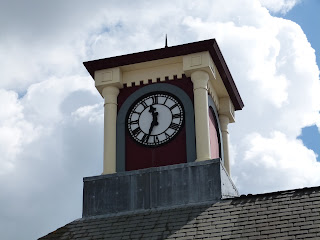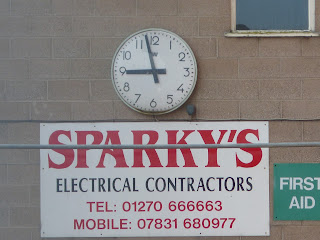Crewe is a town which grew up around the railway works and station, with its connections to many parts of the north-west. In the 40 years from 1831 to 1871, the population rose from 70 to 40,000.
There is a longish walk from the railway station to the town centre, and it is perhaps not an encouraging sign when the first clock is at the funeral directors Joseph O'Connell (the station itself being devoid of a timepiece).
This is on Mill Street, and on this occasion in the light rain.
The writing on the clock face reminds us that time is precious.
So with that in mind, let's hurry on to the town centre.
This clock is locally known as Big Bill, and was installed in April 1957.
I have seen reports that this whole building complex could be demolished, which in my view would be madness as I is the only nice bit of the town centre.
The London and North Western Railway (LNWR) funded this next building, which was originally opened as a cheese market. It is now a general market hall.
Crewe certainly owes much to the railway. As well as the cheese market, the LNWR also provided an endowment towards the building and upkeep of Christ Church.
The church was built in 1843, although the tower was not added until 1877.
From religion to education. The Cheshire campus of the Manchester Metropolitan University can be found on Crewe Road.
I was alerted to the possibility of a clock here by an old photo of another building on the campus. That other building no longer has a clock, but instead I found this:
Crewe Road turns into Nantwich Road as it passes the station. And on Nantwich Road we come across this next shop. Nothing to do with clocks, but those familiar with the recent naming of UK research ships will know why I have included this picture. And it was not until I was looking at the photos later that I noticed the other quirky signs e.g. the park your giraffe here notice.
Anyway, a little further down the road we get back to our theme, with this clock on the premises of John Pass the jewellers.
Onwards to Queen's Park, another legacy of the London and North Western Railway whose main works were nearby. The entrance to the park is dominated by this lovely clock tower.
The park itself celebrates the 50th anniversary of the LNWR and Queen Victoria's Jubilee, hence the relief portrait below.
The tower is 10 metres high, and includes a timepiece manufactured by local clockmaker Mr Blackhurst.
The tower also used to have two drinking fountains, which explains this now incongruous plaque:
Positioning myself to get the above shot of the tower, I glimpsed another clock through the trees on the other side of the road. It is a gated private property, but luckily there was a footpath running along the side of the estate which afforded some reasonable views.
This is now known as Webb House, as proclaimed by the "For Sale" sign by the gate, but the building itself tells of its original use - Webb Orphange. This was opened in 1912 following a bequest from Francis William Webb, the Chief Mechanical Engineer of (yes, you've guessed it) the LNWR.
The orphanage closed in March 1961, but thankfully the building (and clock tower) survives.
Morrisons supermarket is built on part of the old railway works site - I assume that is why this railway feel clock tower was installed.
And there is no getting away from the railway in this posting. The Flying Scotsman was being stabled at Crewe Heritage Centre for a couple of days between duties, and so unusually the site was opened during the week.
I wouldn't normally include these "Paddington Station" clocks (I had passed one on a house on the way the Morrisons and didn't bother top take a picture), but I have relented this time as it is on the platform of the centre's miniature railway.
On to the big trains. This is the prototype Advanced Passenger Train, which was once carried the high hopes of British Rail but is now a museum piece.
And of course I couldn't not include a photograph of the Flying Scotsman.
Back to clocks. This can be found in on of the three signal boxes in the Crewe Heritage Centre.
Not a particularly exciting clock, but the row of shiny signal levers is a sight worth seeing.
I had been trudging round Crewe all morning, so I thought I would take a short-cut through Tesco's car park rather than going on the road which takes you round three sides of the building. Which was a good move as I spotted the clock.
The clock is well-hidden from the road by trees - the photo below is the view from the highway. Not surprising then that I hadn't seen the clock on the way past earlier despite thinking to myself that such a large Tescos might have one.
The following two photos are shots taken through the security fencing into Crewe Alexandra's football ground in Gresty Road.
Back now to the opening theme of this posting - funeral directors. This time we are in the north of the town on Badger Avenue.
And finally, on the southern extremity of the town at the roundabout joining Weston Way with University Way is Rookery Wood Farm. Although clearly not a farm, but some form of eatery.
Which means it is time to depart Crewe. All aboard!























































































































